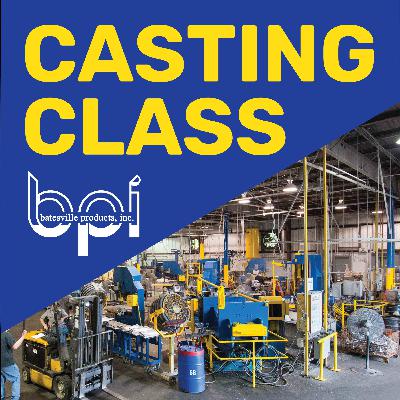Discover Casting Class
Casting Class

Casting Class
Author: Batesville Products
Subscribed: 1Played: 12Subscribe
Share
© Batesville Products
Description
An engineer's guide to manufacturing aluminum castings, hosted by Batesville Products, Inc.
BPI has over 75 years of experience engineering, tooling, casting, machining, inspecting, and polishing aluminum and zinc products for 70 industries nationwide.
Check out more content like videos, written guides, and case studies on our website: batesvilleproducts.com
BPI has over 75 years of experience engineering, tooling, casting, machining, inspecting, and polishing aluminum and zinc products for 70 industries nationwide.
Check out more content like videos, written guides, and case studies on our website: batesvilleproducts.com
35 Episodes
Reverse
Pros, cons, and when to use each casting method. With Mary Jutzi, Rachel Weber, and Stephanie Randolph.
Casting defects, casting methods, sand cores, and what's coming to the casting industry in 2025.
Rachel, Stephanie, and Tim outline 5 steps to transferring your tool to a new foundry:
Visit potential suppliers
Describe your mold/casting
Get a quote
Send your mold for retrofitting
Approve FAI and launch production
Mary, Stephanie, and Rachel compare the mechanical and physical properties of aluminum alloys 319, A356, and A380.
Why might we machine castings? Tolerance, material, design, and process differences when casting from ingot vs. machining from billet. With Rachel Weber, Stephanie Randolph and Tim Williams.
Do I really need heat treat? What is it? What are the pros & cons?
Rachel Weber and Mary Jutzi give a beginner's guide to the heat treatment process.
A glimpse into the foundry industry: aluminum market, labor market, supply chain concerns, onshoring, offshoring, and new technology in manufacturing.
10 types of defects, what went wrong, and what you and your supplier can do to fix it together.
Chapters:
Gas hole porosity
Hydrogen gas porosity
Inclusions
Part design related defects
Mold design related defects
Mold maintenance related defects
Supplier related defects
Defects include: porosity, hydrogen gas porosity, inclusions, shrink, bent, misrun, crack, rough surface finish, flash, and parting line shift.
Differences, tolerances, and when to use each casting method.
Engineer’s guide to designing for permanent mold aluminum casting. Get a printable guide here: https://batesvilleproducts.com/resource/2024-design-guide/
Pros, cons, and key differences between each casting process.
When should I use investment casting (also known as lost-wax casting or precision casting) or permanent mold casting?
How do I get from design to finished product? Tim and Rachel review the manufacturing process step by step, so you know what to expect. There are 11 steps from concept to creation: design, choosing a supplier, tooling, and more!
The pros, cons, and when to use each manufacturing method.
Learn which one is best for your custom design with Rachel Weber and Mary Jutzi.
We met with metal casting engineer Monty Fullerton to learn about 3 design opportunities for complex aluminum permanent mold castings: steel inserts, sand cores, and pulls/slides.
Johnathan and Rachel becomes Myth Busters! There are 8 huge misconceptions in the manufacturing industry:
Is manufacturing in decline?
Are all manufacturing jobs outsourced to other countries?
Are onshored products lower quality or more expensive?
Is manufacturing low-tech with limited innovation?
Is automation eliminating manufacturing jobs?
Are manufacturing jobs low-paying and undesirable?
Is manufacturing just an assembly line, conveyor belt process?
Is manufacturing dirty and bad for the environment?
Questions you NEED to ask when choosing a new supplier! Your shortcut to determining the experience and quality of a potential manufacturer.
With our hosts Tim Williams, Johnathan Johnson, and Rachel Weber.
What impacts casting cost?
9 factors affect the price of a casting:
Material
Design for Manufacturing
Quantity
Complexity
Machining
Heat Treat
Inspection
Surface Finish
Packaging
Learn how casting quotes are calculated so you can optimize your next project!
Tim Weber, with 40+ years of casting experience, looks at the state of foundries today. Changes in market, operation, technology, and more!
How hydrogen, flux, and other additives affect aluminum castings.
With Tim Weber and Mary Jutzi.
Topics
What's Clean Metal (0:39)
Dross, Slag, and Oxides (3:27)
Hydrogen Gas (5:24)
Atmospheric Pressure (6:34)
Using Nitrogen (8:03)
Adding Hydrogen to Aluminum (8:42)
Measuring Gas Level of Melt (11:13)
Temperature's Effect (12:33)
Final Tips for Engineers (13:35)
Which casting material is best for my project?
In this episode, we'll explain the pros and cons of casting each metal, as well as the cost difference.
Thank you to our hosts Tim Weber and Mary Jutzi.





